
QL Resources Berhad is a multinational agro-food corporation which is primarily involved in three business divisions: marine products manufacturing, integrated livestock farming, and palm oil activities.
As of 16 September 2019, QL is worth RM11.3 billion in market capitalisation. In this article, I’ll bring an update on the company’s latest annual results, growth plans, and stock valuation.
Here are 12 things to know about QL Resources before you invest:
1. The marine products manufacturing division recorded an 11.1% year-on-year increase in revenue to RM1.01 billion in 2019 from RM905.4 million in 2018. This is mainly due to the company’s efforts to expand its production capacity, where it can now produce as much as 25,000 metric tons (MT) of chilled surimi and 35,000 MT of frozen products.
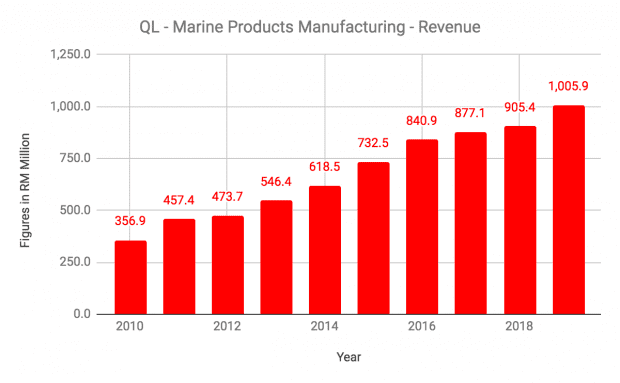
2. The integrated livestock farming division recorded a 17.2% y-o-y growth in revenue to RM2.31 billion in 2019 from RM1.97 billion in 2018. This is mainly due to increases in production of eggs, day-old chicks, and broilers. The number of FamilyMart convenience stores (which is recorded under this division) also grew from 39 to 90. By FY2022, QL intends to expand the number of FamilyMart stores to 300.
| Product | Production (2018) | Production (2019) | Growth |
|---|---|---|---|
| Eggs per day | 5.5 million | 5.7 million | 3.6% |
| Day-old chicks | 40 million | 50 million | 25.0% |
| Broilers | 20 million | 22 million | 10.0% |
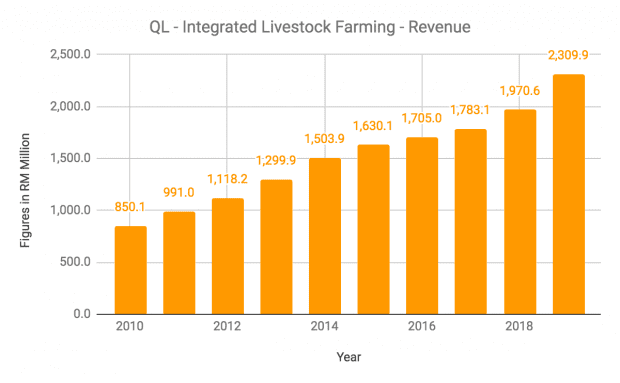
3. The palm oil activities division recorded a 21.7% y-o-y decline in revenue to RM303.2 million in 2019 from RM387.3 million in 2018. This is due to a fall in the average selling price for palm products, which was offset by a rise in production of fresh fruit bunches (FFB) to 139,000 MT in 2019, up from 127,000 MT in 2018.
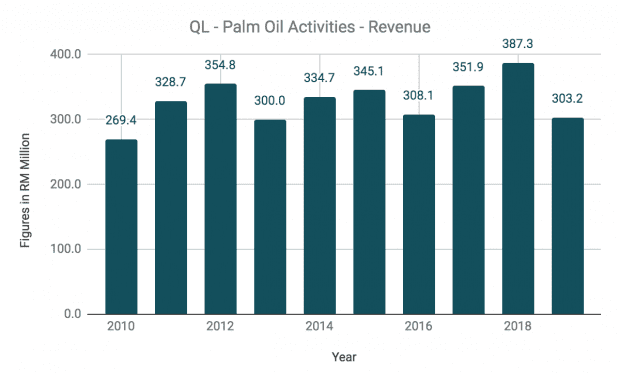
4. Since 2010, QL has achieved a compound annual growth rate (CAGR) of 10.5% and 8.2% for revenue and earnings respectively. This is largely contributed by growth in its marine products manufacturing and integrated lifestyle farming divisions during the period.

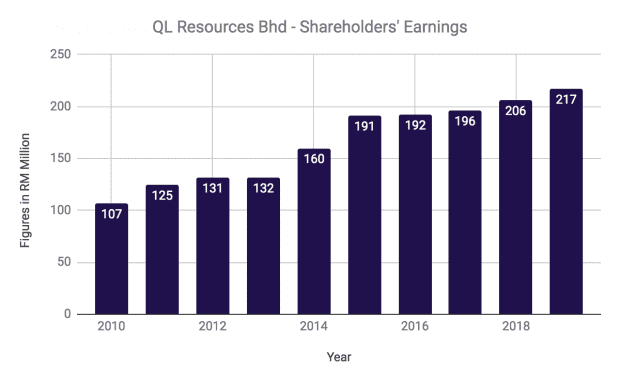
5. From 2010 to 2019, QL has generated a total of RM1.96 billion in operating cash flows, RM31.5 million in dividends from its associate companies, and RM42.3 million in interest income. In addition, QL has raised a total of RM1.07 billion in net equities and long-term borrowings during the period. Out of which, it has spent RM2.41 billion in net capital expenditures and RM475.8 million in dividends to shareholders. The management has chosen to reinvest most of its cash proceeds to expand its business than pay a higher dividend. This has led to steady growth in revenue and profit over the last 10 years.
6. As of 31 March 2019, QL has RM703.5 million in non-current liabilities and RM2.01 billion in total equity, which gives it a gearing ratio is 34.9%. The company also has a cash balance of RM242.1 million.
7. As of 28 June 2019, the five largest shareholders of QL are:
| Direct Shareholders | Shareholding |
|---|---|
| CBG (L) Pte Ltd | 41.19% |
| Farsathy Holdings Sdn Bhd | 11.77% |
| Employees Provident Fund Board | 7.16% |
| Public Ittikal Sequel Fund | 1.24% |
| State Street Bank & Trust Company (Nominee A/C) | 0.78% |
Chairman Chia Song Kun is the largest indirect shareholder of QL with his interest in CBG (L) Pte Ltd. His brothers, Chia Song Kooi and Chia Song Swa, and his son, Chia Lik Khai, are all executive directors of QL. The chairman’s brothers-in-law, Chia Seong Pow and Chia Seong Fatt, are the second largest indirect shareholders of QL with their interests in Farsathy Holdings Sdn Bhd. Both are also directors of QL.
8. QL is investing RM5 million in a frozen surimi-based production line with an annual production capacity of 3,000 MT in Surabaya, Indonesia. The line will be operational in Q3 2019 and, depending on its results, the company may invest more to expand production capacity in the future. QL is also investing RM15 million to set up a cold room facility in Endau, Johor which is scheduled to be operational by FY2020. QL is also planning to launch a prawn aquaculture project in Kota Belud, Sabah. It is currently waiting for approval from the Environmental Impact Assessment Report before it begins.
9. QL has started on the extension phase of its expansion of its new integrated layer farm in Raub, Pahang, which would increase total egg production capacity by 30% to 650,000 eggs a day. In addition, QL aims to raise its egg production in Indonesia to 800,000 eggs per day by FY2020, and has started building a new layer farm facility to double its production capacity in Vietnam.
10. P/E ratio: QL recorded RM0.13 in earnings per share in FY2019. Based on QL’s share price of RM6.97 (as at 16 September 2019), its P/E ratio is 53.62 — the highest in 10 years. Its PEG ratio is similarly high at 6.54.
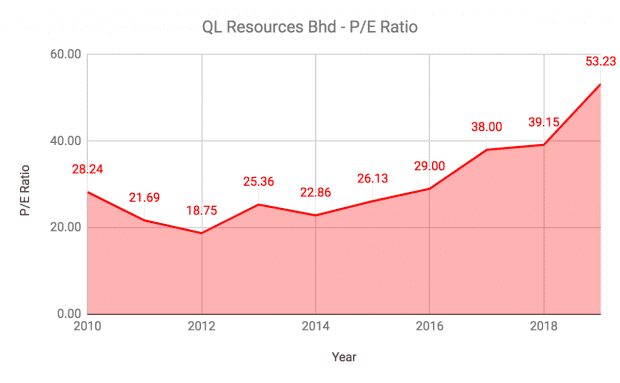
11. P/B ratio: As at 31 March 2019, QL has net assets per share of RM1.19. Hence, QL’s current P/B ratio is 5.86, near its highest in 10 years.
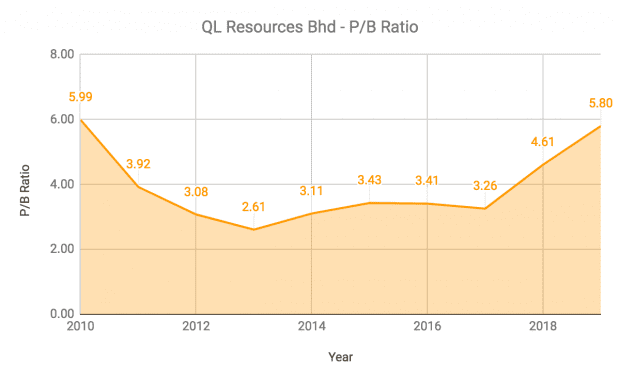
12. Dividend yield: QL paid RM0.045 in dividend per share in FY2019. Hence, its current dividend yield is 0.65%, a 10-year low.
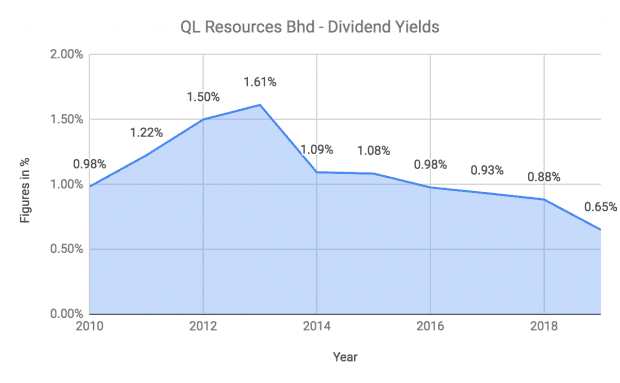
The fifth perspective
QL has delivered steady growth in revenues and earnings over the last 10 years. However, its low dividend makes it unsuitable for investors seeking yield, and its currently high valuation ratios means value investors may prefer to wait for a better opportunity before they consider the company.



